Is it possible to embrace technology, while maintaining a sustainable way of life?
What is the life of our future generations going to look like?
What are the repercussions of our actions today on their futures?
Did you know that native Americans always asked themselves this question before making a move? In fact, he was still wondering what impact their actions would have on the next 7 generations to come. What will be the impact of my gesture today on my children, my grandchildren, my great grandchildren, etc … – Origins
In the United States alone, we produce 74 billion pounds of synthetic chemical PER DAY. That’s 250 lbs / person / day. And that does not include pharmaceuticals, pesticides, fuel and food preservatives. Would you like to explain what we are doing ???? The worst part of all this is that the majority of these chemical molecules have never been tested to verify their safety. We eat them in small quantities every day, we apply them on our skin, we breathe them, we sleep in them, we literally swim in it …
Did you know that about 287 chemical components were discovered in the umbilical cord blood of a nascent baby? -Origins
Did you know that the polluted air of China, the smog of China takes about 7 days to make it over our houses? NASA has made this observation thanks to their satellite. -Origins
In only 2-3 generation, we completely dissociated from the planet. We were created by nature, we are an integral part of nature, but in recent years we have moved away from and dissociated ourselves from it and from the way we are supposed to live. Instead of living in harmony with our planet and nature, we have become predators and it is quite possible that soon, if we do not reflect on how we act and do not change our way of life, we will become parasites For our planet.
Let’s try to understand what’s going on. In 2017, people no longer have the vivacity of yesterday, they are stressed, tired, obese, infertile, sick.
Of all these chemicals that are created every day, many of them are known for their adverse effects on our health. They can be irritating, cause allergenic reactions, some are endocrine disruptors, others damage and affect the functioning of the mitochondria, there are even that are potential carcinogens. The residues of these chemicals that are often found in our sewers also have an impact on terrestrial, aquatic wildlife and on the quality of our drinking water. There is a very large chain of reactions following the use of these products.
Here is a list of the chemicals most used and known. I hope this information will lead you to reflect on your actions and your future purchases. As I always say “Money talk” Express yourself when shopping, choose products that are less harmful and less toxic to you and the environment. This sends a clear and direct message to the industry. This is the best way to tell them that we do not want this kind of product and they will have to adjust to our demands and do better. It is always possible to do better.
When we don’t succeed in life, it’s not because of the lack of resources, it’s your lack of RESOURCEFULNESS that stops you. -Tony Robbins
And most importantly, learn to read the labels when you buy a product.
Suppose I asked you to close your eyes and that I was going to give you something to eat. I do not tell you what it is, but I inform you that it is possibly poison, would you let me do it? Of course not. Well that’s exactly what you do every time you put in your grocery cart products you do not have a clue what they contain. Today I will help you to demystify all this.
*******************
HERE IS A LIST OF CHEMICALS TO AVOID.
BHA and BHT
These are synthetic antioxidants, they help ensure that oils do not rancid too quickly. They are used as preservatives. They are suspected of interfering with hormonal functions, being carcinogenic (BHA) and being harmful to fish and wildlife.
The state of California requires that warning labels on products containing BHA, tell consumers that this ingredient can cause cancer.
It includes: Moisturizing products, make-up, lipstick, chips, vegetable oils, nut butters, chewing gum
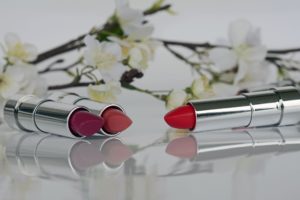
*************************************************************************************************************************************************************************************
What is an Endocrine Disruptor: These are chemical substances of synthetic origin and very rarely of natural origin, which can interfere with the functioning of our hormonal system. They can have a detrimental effect on the communication power of our hormones. Even a minimal amount, but with prolonged use, may suffice to disrupt your hormonal system and affect your health and reproductive system.
It is often referred to as Xeno-estrogen. Xeno means: Stranger. They are found regularly in our beauty products. Do not confuse Xeno-estrogen which usually comes from petroleum derivative or synthetic molecule and Phytoestrogens which are a natural molecule derived from plants. It will certainly be another topic.
Here are some examples of endocrine disruptor: BPA, BHA, CYCLOPENTASILOXANE, DIETHYL PHTHALATE, OXYBENZONE, PARABENS, PHATALATES, TRICLOSAN. This list is unfortunately not exhaustive: it is highly probable that as new studies appear, new endocrine disruptors will be discovered.
*****************************************************************************************************************************************************************************************
Petrolatum
It is a mineral oil jelly obtained from petroleum, it is a semi-solid mixture of hydrocarbon. The European Union classifies it in the section of carcinogens.
It is used as a barrier to block skin moisture. It is found in several moisturizing products, some hair products (for shine), in lip balms, etc …
Did you know that the second ingredient in the Glaxal Sensitive Skin Moisturizer recommended to me by my children’s pediatrician is Petrolatum, followed by Cetearyl alcohol (OK) and Parrafinum liquidum …. Super! -Me
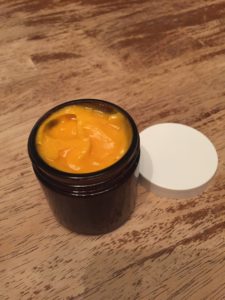
So I decided to make my own cream.
The dyes (P-PHENYLENEDIAMINE)
Be on the lookout for P-PHENYLENEDIAMINE and the dyes identified by “CI” followed by five digits. Dyes starting with “CI 1 ….” are particularly to be avoided.
They could be carcinogenic and contain heavy metals toxic to the brain. It is an allergenic too.
Para-phenylenediamine is a dye derived from the coal tar used in some hair dyes, the darkest dyes contain more than the clear. Coal tar is recognized as a human carcinogen. Other colors are used in many cosmetic products.
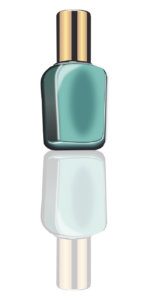
Formaldehyde Liberators
These are preservatives that are widely used to kill microorganisms, or prevent their growth in products. They are used in a wide range of cosmetic products, such as hair colorations, nail polish, soaps and detergents, skin cleansers, industrial products, ink for photocopying. They are also used in dentistry and some vaccines.
They slowly and continuously release small amounts of formaldehyde, a carcinogen.
It would cause irritation of the skin and eyes and would be an allergy trigger.
Here are some of their identifications: DMDM HYDANTOIN, DIAZOLIDINYL UREA, IMIDAZOLIDINYL UREA, METHENAMINE, QUARTERNIUM-15, N-methylolchloracetamide, N-methylolethanolamine and
2-Bromo-2-nitropropane-1,3-Diol
The International Agency for Research on Cancer classifies formaldehyde as a known carcinogen
Sodium lauryl Sulfate and Sodium Laureth Sulfate
Sodium lauryl sulfate is used as an emulsifier and detergent. It is found in foaming products such as shampoos, cleansers and bath products. It is an irritant to the skin, eyes and respiratory tract, it could cause allergies. In addition, it is toxic to aquatic organisms.
Sodium Laureth sulfate is an ethyoxylated ingredient. Like PEGs, it can contain measurable amounts of 1,4-dioxane and is potentially carcinogenic.
1,4-Dioxane is listed on the Critical Ingredient List for restricted or prohibited use in cosmetics. However, this list does not control the toxic ingredients as a contaminant.
A contaminant is an ingredient that is found in a product by the result of an action. It is not intentionally added, but it is nevertheless present in the latter as a residue of production.
The Parabens
You have definitely already read about a product without the PARABEN.
Parabens are preservatives that are less used nowadays but are still present.
Parabens are naturally present in low concentrations in certain foods such as barley, strawberries, currants, vanilla, carrots and onions. However, those used in beauty products are synthetic forms, derived from petroleum. Parabens of food are metabolized when ingested, which makes them less strongly estrogenic. On the other hand, when applied to the skin, they are easily absorbed by the body and are considered disrupters of the endocrine system. They are found in body milk, shampoo, hair mask, lip balm, etc …
In order to avoid them, choose a product with the inscription without paraben and without perfume / fragrance ***.
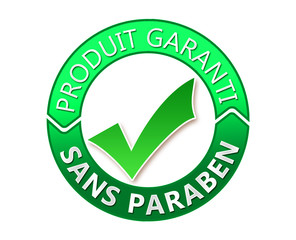
Caution: “Without parabens” does not mean that there are no other potentially toxic preservatives.
*** Since perfume recipes are considered trade secrets, manufacturers are not required to disclose the particular fragrance ingredients.
Methylisothiazolinone & Methylchlorothiazolinone
As a replacement for Paraben, producers regularly and increasingly use methylisothazolinone as a preservative. Several reports are beginning to demonstrate that this ingredients is highly allergenic and irritating to the skin. It is also found on the list of ingredients under the inscription MIT
Watch this segment of the show the invoice of March 10, 2015. An enemy so close
Phthalates
Phthalates are often used as a fixing agent. This type of molecule is particularly present in perfumes, nail polish and some styling products.
Dibutyl phthalate is used as a plasticizer in nail products. It is considered toxic to reproduction and suspected of interfering with hormonal function (Endocrine Disruptor) It is also harmful to fish and wildlife.
The best way to avoid phthalates in cosmetics is to use products in which the terms perfume and fragrance are not included in the list of ingredients or to use only products whose perfumes are 100% original Natural, such as essential oils.
Caution 1: DIETHYL PHTHALATE is widely used in perfumes to fix and prolong their scent. In this case, it is not listed as an ingredient in the INCI list. Indeed, whatever their composition, the perfumes are all indicated on the INCI list under the same generic term: FRAGRANCE, which does not make it possible to know whether the perfume under consideration contains phthalates or not. Phthalates can therefore be present in your fragrance or in cosmetic creams (which are almost all perfumed) without it being visible on the INCI list of ingredients.
Caution 2: As far as phthalates are concerned, it is necessary not only to consider the product. As with Bisphenol-A, there are real risks of migration of phthalates between the plastic of the container and its contents. It is therefore necessary to avoid all the products contained in a plastic of PVC type which is identified by a particular symbol: the number 3 in a recycling triangle. Until recently it was considered that a very common plastic called PET (polyethylene terephthalate) was not likely to release phthalates. However, a German study showed that the mineral water contained in PET plastic bottles contained much more phthalates than water contained in a glass bottle. As a precaution, I recommend you avoid any form of plastics.
“Endocrine disruptors in bottled mineral water: total estrogenic burden and migration from plastic bottles” by Martin Wagner and Jörg Oehlmann, 2009. https://www.ncbi.nlm.nih.gov/pubmed/19274472
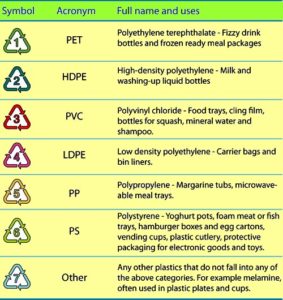
PS: LE # 6 IS THE FAST STYROFOAM GOULET IF OFTEN USED FOR COFFEE.
The Triclosan
Triclosan is generally used as a preservative and antibacterial in anti-sudorific, toothpastes, cleansers and hand disinfectants. Triclosan can also be found in a wide range of household products, including garbage bags, toys, wipes, mattresses, toiletries, clothing, upholstery and paints.
It is suspected to interfere with hormonal function and contribute to the resistance of certain bacteria to antibiotics. It is also harmful to fish and wildlife.
Its synonyms are: 2,4,4′-TRICHLORO-2′-HYDROXY DIPHENYL ETHER, 5-CHLORO-2- (2,4-DICHLOROPHENOXY) -PENOL, 5-CHLORO-2- (2,4-DICHLOROPHENOXY) PHENOL 5-CHLORO-2- (2,4-DICHLOROPHENOXY) PHENOL, 5-CHLORO2 (2,4DICHLOROPHENOXY), 2,4,4′-TRICHLORO-2′-HYDROXYDIPHENYL ETHER, 5-CHLORO- -DICHLOROPHENOXY) PHENOL)
Ingredients related to DEA
COCAMIDE DEA and LAURAMIDE DEA
Ingredients linked to DEA (diethanolamine) are used to make the cosmetics creamy or sparkling and adjust the pH, neutralizing the acidity of other ingredients. They are mainly found in creamy and foaming cosmetics such as soaps, makeup removers, shampoos and moisturizing products.
MEA (monoethanolamine) and TEA (triethanolamine) are similar chemicals. Like DEA, these substances can react with other chemicals present in cosmetics to form carcinogenic nitrosamines. They are also harmful to fish and wildlife.
PHENOXYETHANOL
It is found in baby wipes as a preservative.
There is as yet no study showing an endocrine disruption effect per se, but an ANSM assessment has shown reproductive risks. A recommendation has been sent to the European Commission to ban this substance in products intended for children under 3 years of age (especially in baby wipes).
Perfumes and Fragrances
Mixing chemicals that can trigger allergies and asthma, some are associated with cancer and neon poisoning. Harmful to fish and wildlife.
The fragrances are all indicated on the INCI list under the same generic term: FRAGRANCE, which does not make it possible to know whether the perfume under consideration contains phthalates or not. Phthalates can therefore be present in your fragrance or in cosmetic creams (which are almost all perfumed) without it being visible on the INCI list of ingredients.
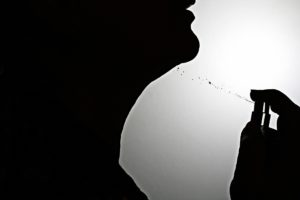
The PEG
PEG (polyethylene glycols) are petroleum-based compounds (forms of plastics) widely used in cosmetics as thickeners, solvents, softeners, and serves as a penetration multiplier allowing skin to absorb moisturizers more easily.
PEGs generally serve as the basis for beauty creams. It may contain 1,4-dioxane, which is potentially carcinogenic.
On the other hand, they are not very biodegradable.
The Siloxanes – Dimethicone
They are used in cosmetics to soften, smooth, moisten and texture.
In fact, dimethicone forms a thin layer on top of the skin, like a Saran wrap film, which traps the hydration inwardly (in the skin). The problem is that the skin is not just an organ that absorbs, but it is also an organ that eliminates toxins, through sweating. It is therefore essential that she can sweat and breathe freely. Dimethicone intervenes in this process and prevents the skin from breathing normally.
Cyclotetrasiloxane is considered an endocrine disruptor and potentially toxic for reproduction.
Harmful to fish and wildlife.
Silicones are very present in cosmetics (shampoo, creams, deodorants …)
Alkylphenols: Methylphenols and Ethylpenols
Emulsifiers: They may be present in certain body and hair cleansers, shaving foam, styling products, hair dyes, spermicides, etc.
The toxic and endocrine disrupting effects of alkylphenols have been demonstrated by several scientific studies: malformations in the reproductive organs, reduction in the number of spermatozoa and disturbance of the balance of reproductive hormones. Interestingly, nonylphenol is an active ingredient in some spermicides
Avoid all products containing NONYLPHENOL or NONOXYNOL
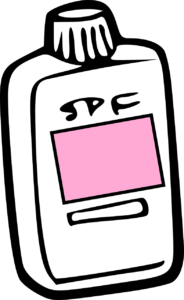
UV radiation chemical filter: Benzophenone, oxybenzone.
Present in sunscreens, some hair products (shampoos, day cream …) or nail varnish, these chemical molecules that filter the UV also have a disruptive effect on our endocrine system
Avoid molecules: BENZOPHENONE, OXYBENZONE, ETHYLHEXYL METHOXYCINNAMATE, or 4-METHYLBENZYLIDENE CAMPHRE.
Studies have shown that these chemical filters mimic the action of female hormones, causing delays in puberty and disturbances in the development of reproductive organs.
Screens in the form of nanoparticles are also problematic, thus promoting their transcutaneous penetration, these are suspected of being toxic to the organism.
Alternatives, use products designed with mineral filters, such as zinc oxide and titanium dioxide.
Aluminum and Aluminum Salts
In certain classic and solar creams, it serves to facilitate the application on the skin and to make it as soft and pleasant as possible. Used in make-up, it improves the hold on the skin.
Aluminum salts are also found in antiperspirants to control and limit sweating. Used as an antiperspirant, it prevents sweat from forming on the surface of the skin by tightening the pores, and therefore prevents the body from evacuating its toxins. This can lead to blocking the secretion channels of the sweat glands causing inflammatory reactions.
Aluminum salts in food products processed as additives, preservatives or colorants are also found in certain drugs and vaccines as an adjuvant to enhance their action.
It also has a strong irritating potential.
Introduced into the body, aluminum can cause various pathologies such as Alzheimer’s disease or breast cancer to appear …
*************************
I hope that you liked this post and that it help you understand a little more about harsh and toxic chemicals in our beauty product.
My inspiration to write this post comes from these sites and from the documentary ORIGINS Our Roots. Our Planet. Our Future

If you wish to learn more about this subject, I highly recommend these links:
http://www.sabotage-hormonal.org/IMG/pdf/Sabotage-hormonal-2009.pdf
https://documentarystorm.com/origins/
Study on effect of Phtalates and fertility in men

